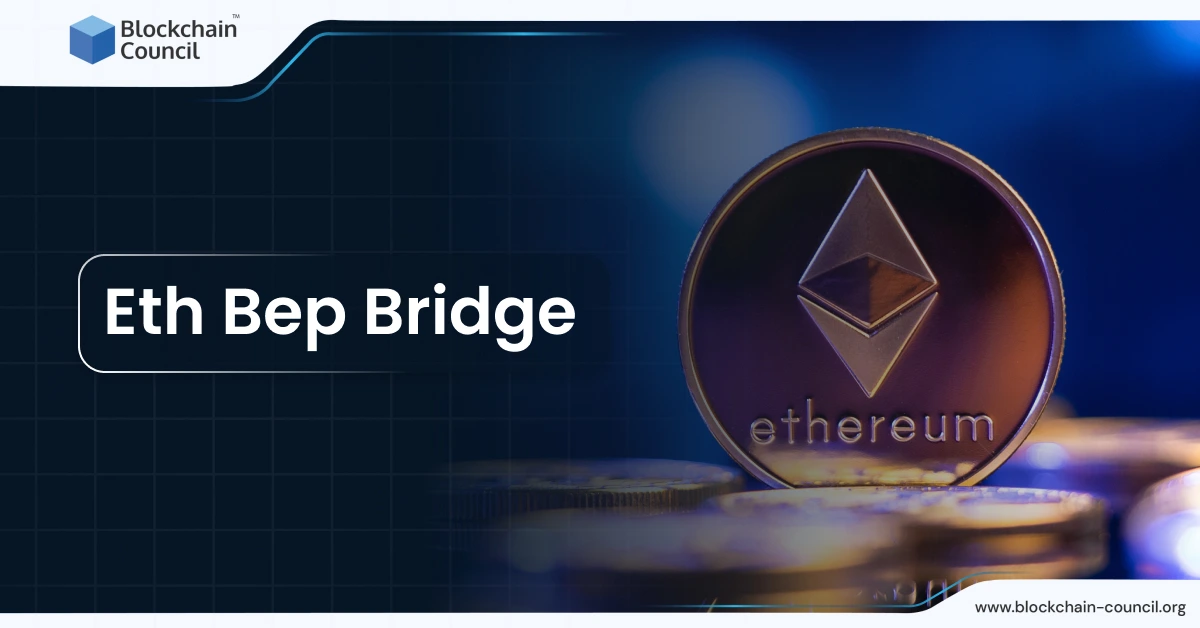
- Blockchain Council
- September 12, 2024
The ETH-BEP Bridge is important in cryptocurrency, enabling asset transfers between Ethereum and Binance Smart Chain (BSC). This bridge allows users to switch tokens between these two platforms, facilitating smooth interaction with various Blockchain environments. Let’s look into what the ETH-BEP Bridge does, how it operates, and why it is becoming more relevant for those involved in decentralized finance (DeFi) and other Blockchain services.
What is the ETH-BEP Bridge?
The ETH-BEP Bridge enables tokens to move between Ethereum and Binance Smart Chain. Ethereum uses the ERC-20 standard, while BSC uses the BEP-20 standard; these standards define how tokens function on their respective Blockchains. The bridge serves as a link, allowing tokens to be transferred between these networks without losing value or function.
How the ETH-BEP Bridge Works
The bridge process includes wrapping and unwrapping tokens. When transferring a token from Ethereum to BSC, it is wrapped into a BEP-20 token that represents the original Ethereum asset on BSC. Conversely, when moving from BSC back to Ethereum, the BEP-20 token is unwrapped into its original ERC-20 format. This process ensures the token maintains its value across different networks while adhering to the new protocol.
To use the bridge, you need a wallet like MetaMask configured with Ethereum and BSC. Connect your wallet to a bridge platform, select the amount of tokens, and approve the transaction. Fees are paid, covering gas costs on both networks. Common platforms for these transfers include MetaMask’s bridge aggregator, Binance Bridge, and ZeroSwap’s ETH-BSC Bridge.
Popular Bridge Solutions
Several bridge options help move assets between Ethereum and BSC:
- MetaMask Bridge Aggregator: MetaMask provides a bridge aggregator within its platform that connects with third-party providers like Connext, Hop, and Celer cBridge, allowing users to compare routes and choose the best transfer method.
- Binance Bridge: This well-known bridge wraps Ethereum’s ERC-20 tokens into BEP-20 tokens on BSC. It’s widely used for accessing BSC’s DeFi platforms like PancakeSwap and Venus Protocol and holds billions in locked tokens.
- ZeroSwap’s ETH-BSC Bridge: This bridge supports ERC-20 to BEP-20 transfers with lower costs and faster speeds, making it user-friendly with guided steps for wallet connections and transfers.
Why Use the ETH-BEP Bridge?
The ETH-BEP Bridge offers several benefits:
- Access to Different Networks: Transferring tokens between Ethereum and BSC allows users to explore various ecosystems with unique apps, lower fees, and diverse investment opportunities.
- Reduced Costs: Ethereum’s gas fees are often high, making BSC a more attractive option due to its lower costs when transferring through the bridge.
- Greater Flexibility: The bridge provides increased flexibility in asset management, enabling users to spread their holdings across various Blockchains—a crucial feature as DeFi and Blockchain use grow.
How to Use the ETH-BEP Bridge?
Using the ETH-BEP Bridge is straightforward:
- Connect Your Wallet: Connect a Web3 wallet like MetaMask to the bridge platform.
- Select Networks: Choose the source and destination networks, such as Ethereum and BSC.
- Choose Token and Amount: Select the token and amount to transfer. The bridge will wrap it into the suitable format for the destination.
- Approve and Transfer: Confirm the transaction in your wallet. Fees will apply for gas costs.
- Confirmation: After confirmation, the wrapped token will appear in your wallet on the new network, ready for use.
Conclusion
The ETH-BEP Bridge is essential for those involved in DeFi or Blockchain activities across Ethereum and Binance Smart Chain. It streamlines asset transfers, offering benefits like lower fees, quicker transactions, and broader access to various financial apps. By connecting these two major ecosystems, the ETH-BEP Bridge increases Blockchain technology’s usability, making it accessible for users at all levels.



































































 Guides
Guides News
News Blockchain
Blockchain Cryptocurrency
& Digital Assets
Cryptocurrency
& Digital Assets Web3
Web3 Metaverse & NFTs
Metaverse & NFTs
